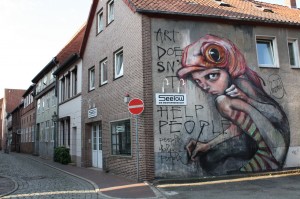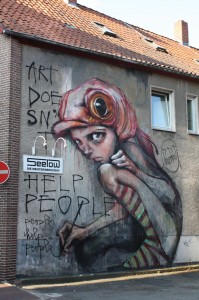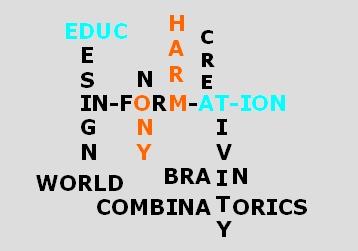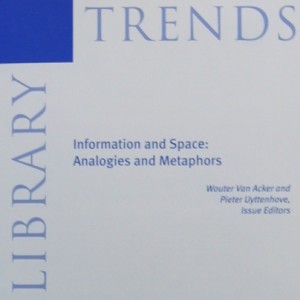Archive for the 'Education' Category
May 29th, 2011 by thapke
 By an English friend I was pointed to a graffiti which exists in Lüneburg, the town where I live, and which was done in 2009 within an Urban Art Project by the Leuphana University. It was created by two artists which call themselves Herakut and contained the text "Art doesn`t help people, people help people".
By an English friend I was pointed to a graffiti which exists in Lüneburg, the town where I live, and which was done in 2009 within an Urban Art Project by the Leuphana University. It was created by two artists which call themselves Herakut and contained the text "Art doesn`t help people, people help people".
 But art is made by people, isn’t it!?
But art is made by people, isn’t it!?
Some videos on this special piece of art and also the descriptions of the other artworks can be viewed at the website.
The art project was "part of Leuphana University’s orientation programme for new students".
Starting their study at Leuphana, students have the so-called Leuphana Semester which is unique for German universities and also includes special introductions into scholarly work as well as the promotion of information literacy.
May 9th, 2008 by thapke
Root-Bernstein described the connection between art and the sciences in the view towards creativity in his abstract:
Many people view arts and sciences as being different because sciences yield objective answers to problems whereas arts produce subjective experiences I argue that art and science are on a continuum in which artists work with possible worlds whereas scientists are constrained to working in this world. But sometimes perceiving this world differently is the key to making discoveries. Thus, arts and sciences are on a continuum in which artistic thinking produces possibilities that scientists can evaluate for efficacy here and now. Not surprisingly, then, many of the most innovative scientists have had avocations in the arts, and some of the most innovative artists have had avocations in the sciences. These polymaths have often written or spoken about how their arts involvments have benefitted their scientific creativity and may provide a model for fostering a more innovative education.
Robert Root-Bernstein: The art of innovation: polymthas and universality of the creative process, in: Larisa V. Shavinia (Ed.): The International Handbook of Innovation. Oxford: Elsevier, 2003. PP. 267-278.
He argues that “artistic scientists and engineers have more image-ination, musically talented
ones duet (do it) better, and the verbally inclined have the skills to become pundits. Seriously.” (p. 270), and cited (on p. 268) Ostwald who “produced a large body of work on scientific genius that validated the polymath hypothesis”.
This supported by J. Rogers Hollingsworth who argued that:
the wider the range of experience and knowledge of the scientist, the more fields of science his/her work are likely to influence and the greater the importance with which it will be perceived. (p. 140)
J. Rogers Hollingsworth, “High Cognitive Complexity and the Making of Major Scientific Discoveries,” in Arnaud Sales and Marcel Fournier, eds., Knowledge, Communication and Creativity. (London and Thousand Oaks, California: Sage Publications, 2007). pp. 129-155.
Ostwald is mentioned here in a table of “Twentieth-century scientists who made major discoveries and were also quite active in music, art, writing, crafts and politics” (pp. 142-144)
May 9th, 2008 by thapke
The importance to think about creativity in information and library science (1) led to considerations about how to develop information systems to support people in their creativity, e.g. in musics (2) or how the form of accessing information inluences the generation of ideas and creativity, here e.g. for managers (3).
- Petrowski, Mary Jane: Creativity research: Implications for teaching, learning and thinking, in:
Reference services review 28 (2000) 304-312
- Barry Eaglestone, Nigel Ford, Luy J. Brwon, Adrian Moore: Information systems and creativity : an emprical study, in: Journal of Documentation 63 (2007) 443-464
- Vandenbosch, B., Fay, S. and Saatçioglu, A.: “Where Ideas Come From: A Systemic View Of Inquiry,” in: Sprouts: Working Papers on Information Environments. Systems and Organizations, Volume 1 (2001) 2, 109-131.
May 6th, 2008 by thapke
The colloid chemist Ernst Alfred Hauser wrote about Ostwald in 1951:
… his greatest contribution to science and education was not his discovery of how to form oxides of nitrogen by passing a mixture of air and ammonia over a platinum catalyst (a discovery for which he received the Nobel Prize for Chemistry in 1909), but rather the emphasis he always placed in his writings and lectures on the need of the young generations’ acquiring at least a basic knowledge of what he called ‘basic philosophy’ during the years it devotes to its education in colleges and universities.
Ernst Alfred Hauser, The lack of natural philosophy in our education. In memoriam of Wilhelm Ostwald, in: Journal of Chemical Education 28 (1951) 492-494.
April 30th, 2008 by thapke
Ostwald on Education by W. W. Sawyer
Friedrich Wilhelm Ostwald was one of the most colourful characters of his time […] A brilliant scientist and an inspiring teacher, he was a man of wide sympathies and varied interests. He campaigned vigorously and courageously for a number of causes; for example, one of his books, published in 1912 in the militarist and nationalistic Germany of Wilhelm II, called for “internationalism, pacifism and a systematic plan for the preservation of natural energy resources”. [1] He was intensely and outspokenly critical of the school system as it existed in that time and place, and made extensive studies relating to education.
April 29th, 2008 by thapke
Still today the connection between creativity and combinatorics is the topic of research.
One example is the work of Dean Keith Simonton:
March 30th, 2008 by thapke
"In-formation" and education has a strong connection, e.g. through information literacy. In the end of a paper in the book “European Modernism and the Information Society” Michael Buckland mentioned the connection between documentation and the "technology/technique of intellectual work" what also has strong connections to education! Efforts and guides to research methods for students grew with the beginning of the 20th century.
All this supports the German philosopher Ernst Bloch’s quote: "It will be perceived with the aim of in-formatio about the world and of the world itself."
Ernst Bloch, Tübinger Einleitung in die Philosophie (Frankfurt a.M. 1977).
March 20th, 2008 by thapke
Ostwald’s activities in education showed his sense for individual development combined with systematic treatment. He believed that “the art of discovery“ should become “a part of the intellectual inventory of every one.“ Ostwald was aware that teaching research skills combined with enabling effective use of libraries was important. He suggested that teaching centers should be created at technical universities to improve techniques for the presentation of engineering knowledge and that these should be integrated into engineering education.
- Wilhelm Ostwald, ‘The art of discovery. Making discoveries by rule’, Scientific American Supplement 70, no. 1807 (1910), 123-124.
January 1st, 2008 by thapke
“Combinatorics doesn’t replace productive imagination only, but is superior to it!”
So creativity included for Ostwald not only “productive imagination†but also “combinatoricsâ€. From his view ideas and discoveries are often only “a novel combination of existing componentsâ€. Newly-discovered facts in scientific research also has to be combined with diverse existing facts to create new insights. His idea on creativity corresponds with modern views concerning an alternative exposure to copyright and intellectual property within the “Creative Commons†licences: “Share, reuse, and remix – legal†(http://creativecommons.org).

Wilhelm Ostwald (1929). Combinatorics and productive imagination (Kombinatorik und schaffende Phantasie. In: Forschen und Nutzen: Wilhelm Ostwald zur wissenschaftlichen Arbeit (pp. 28-30). Berlin: Akademie-Verlag, 1978.
 Five years after the “Analogous Spaces” conference its proceedings has been published with the title “Information and Space: Analogies and Metaphors” in a special issue of the journal “Library Trends” (Volume 61, Number 2, Fall 2012)
Five years after the “Analogous Spaces” conference its proceedings has been published with the title “Information and Space: Analogies and Metaphors” in a special issue of the journal “Library Trends” (Volume 61, Number 2, Fall 2012)

